Atractylenolide I inhibits angiogenesis and reverses sunitinib resistance in clear cell renal cell carcinoma through ATP6V0D2-mediated autophagic degradation of EPAS1/HIF2α
- PMID: 39477683
- PMCID: PMC11849937
- DOI: 10.1080/15548627.2024.2421699
Atractylenolide I inhibits angiogenesis and reverses sunitinib resistance in clear cell renal cell carcinoma through ATP6V0D2-mediated autophagic degradation of EPAS1/HIF2α
Abstract
Clear cell renal cell carcinoma (ccRCC) is tightly associated with VHL (von Hippel-Lindau tumor suppressor) mutation and dysregulated angiogenesis. Accumulating evidence indicates that antiangiogenic treatment abolishing tumor angiogenesis can achieve longer disease-free survival in patients with ccRCC. Atractylenolide I (ATL-I) is one of the main active compounds in Atractylodes macrocephala root extract and exhibits various pharmacological effects, including anti-inflammatory and antitumor effects. In this study, we revealed the potent antitumor activity of ATL-I in ccRCC. ATL-I exhibited robust antiangiogenic capacity by inhibiting EPAS1/HIF2α-mediated VEGFA production in VHL-deficient ccRCC, and it promoted autophagic degradation of EPAS1 by upregulating the ATPase subunit ATP6V0D2 (ATPase H+ transporting V0 subunit d2) to increase lysosomal function and facilitated fusion between autophagosomes and lysosomes. Mechanistically, ATP6V0D2 directly bound to RAB7 and VPS41 and promoted the RAB7-HOPS interaction, facilitating SNARE complex assembly and autophagosome-lysosome fusion. Moreover, ATP6V0D2 promoted autolysosome degradation by increasing the acidification and activity of lysosomes during the later stages of macroautophagy/autophagy. Additionally, we found that ATL-I could decrease the level of EPAS1, which was upregulated in sunitinib-resistant cells, thus reversing sunitinib resistance. Collectively, our findings demonstrate that ATL-I is a robust antiangiogenic and antitumor lead compound with potential clinical application for ccRCC therapy.Abbreviations: ATL-I: atractylenolide I; ATP6V0D2: ATPase H+ transporting V0 subunit d2; CAM: chick chorioallantoic membrane; ccRCC: clear cell renal cell carcinoma; CTSB: cathepsin B; CTSD: cathepsin D; GO: Gene Ontology; HIF-1: HIF1A-ARNT heterodimer; HOPS: homotypic fusion and protein sorting; KDR/VEGFR: kinase insert domain receptor; KEGG: Kyoto Encyclopedia of Genes and Genomes; RCC: renal cell carcinoma; SNARE: soluble N-ethylmaleimide-sensitive factor attachment protein receptor; TCGA: The Cancer Genome Atlas; TEM: transmission electron microscopy; TKI: tyrosine kinase inhibitor; V-ATPase: vacuolar-type H±translocating ATPase; VEGF: vascular endothelial growth factor; VHL: von Hippel-Lindau tumor suppressor.
Keywords: ATP6V0D2; Atractylenolide I; HIF2α; autophagic degradation; clear cell renal cell carcinoma.
Conflict of interest statement
No potential conflict of interest was reported by the author(s).
Figures
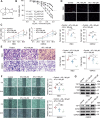
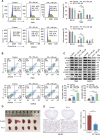
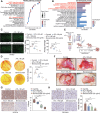
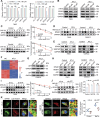
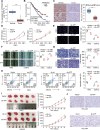
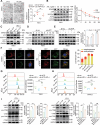

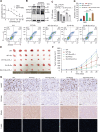
Similar articles
-
CYP1B1 promotes angiogenesis and sunitinib resistance in clear cell renal cell carcinoma via USP5-mediated HIF2α deubiquitination.Neoplasia. 2025 Aug;66:101186. doi: 10.1016/j.neo.2025.101186. Epub 2025 May 27. Neoplasia. 2025. PMID: 40435846 Free PMC article. Review.
-
Combination of Temsirolimus and tyrosine kinase inhibitors in renal carcinoma and endothelial cell lines.J Cancer Res Clin Oncol. 2012 Jun;138(6):907-16. doi: 10.1007/s00432-012-1162-x. Epub 2012 Feb 10. J Cancer Res Clin Oncol. 2012. PMID: 22322364 Free PMC article.
-
VHL restoration in clear cell renal cell carcinoma improves NK cell infiltration and function.Cancer Immunol Immunother. 2025 Jul 30;74(9):278. doi: 10.1007/s00262-025-04132-x. Cancer Immunol Immunother. 2025. PMID: 40736709 Free PMC article.
-
A Systematic Review and Meta-analysis Comparing the Effectiveness and Adverse Effects of Different Systemic Treatments for Non-clear Cell Renal Cell Carcinoma.Eur Urol. 2017 Mar;71(3):426-436. doi: 10.1016/j.eururo.2016.11.020. Epub 2016 Dec 8. Eur Urol. 2017. PMID: 27939075
-
Requirement for Cyclin D1 Underlies Cell-Autonomous HIF2 Dependence in Kidney Cancer.Cancer Discov. 2025 Jul 3;15(7):1484-1504. doi: 10.1158/2159-8290.CD-24-1378. Cancer Discov. 2025. PMID: 40178040 Free PMC article.
Cited by
-
Antitumor and immunomodulatory activities of diphyllin and its derivatives.Bioorg Med Chem. 2025 Jul 1;124:118197. doi: 10.1016/j.bmc.2025.118197. Epub 2025 Apr 14. Bioorg Med Chem. 2025. PMID: 40253992 Review.
-
CYP1B1 promotes angiogenesis and sunitinib resistance in clear cell renal cell carcinoma via USP5-mediated HIF2α deubiquitination.Neoplasia. 2025 Aug;66:101186. doi: 10.1016/j.neo.2025.101186. Epub 2025 May 27. Neoplasia. 2025. PMID: 40435846 Free PMC article. Review.
-
Methyltransferase-like 3 is a target for the diagnose and therapy of clear cell renal carcinoma.Front Pharmacol. 2025 Apr 17;16:1534655. doi: 10.3389/fphar.2025.1534655. eCollection 2025. Front Pharmacol. 2025. PMID: 40313614 Free PMC article. Review.
-
Single-cell RNA sequencing technology was employed to construct a risk prediction model for genes associated with pyroptosis and ferroptosis in lung adenocarcinoma.Respir Res. 2025 Jul 18;26(1):249. doi: 10.1186/s12931-025-03323-5. Respir Res. 2025. PMID: 40682067 Free PMC article.
-
Endothelial Per-Arnt-Sim domain-containing protein 1 expression is correlated with poor prognosis and promotes invasion and metastasis in gastric cancer.World J Gastrointest Oncol. 2025 Jun 15;17(6):105213. doi: 10.4251/wjgo.v17.i6.105213. World J Gastrointest Oncol. 2025. PMID: 40547177 Free PMC article.
References
Publication types
MeSH terms
Substances
LinkOut - more resources
Full Text Sources
Other Literature Sources
Medical
Miscellaneous
